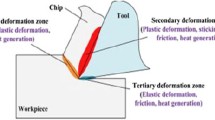Abstract
In interrupted cutting, chips occur as intermittent and cutting tool may be damaged under severe variable loading. And it is known that the cutting forces cause transverse cracks on the rake face, and cutting tool may be damaged during interrupted cutting under mechanical and thermal fatigue in a short period of time. In this work, carbide inserts and forged SAE 4340 workpiece with axial slots were used in interrupted turning. The hardness values of some points on rake face near the cutting edge were measured, and cracks and failures on cutting tool were displayed by scanning electron microscopy (SEM). Additionally, milling experiments were conducted with carbide inserts on C45 medium carbon steel. In the interrupted cutting, the effect of work hardening of cobalt in sintered carbide cutting tool on tool failure was investigated. According to the results, micro hardness of sintered carbide cutting tool increased due to work hardening of cobalt, and this caused the micro crack formation on cutting tool.
Similar content being viewed by others
References
Bhatia SM, Pandey PC, Shan HS (1978) Thermal cracking of carbide tools during intermittent cutting. Wear 51(2):201–211
Chakraverti G, Pandey PC, Mehda NK (1984) Analysis of tool temperature fluctuation in interrupted cutting. Precis Eng 6(2):99–105
Wang ZY, Sahay C, Rajurkar KP (1996) Tool temperatures and crack development in milling cutters. Int J Mach Tool Manuf 36(1):129–140
Hamid AA, Wifi AS, Gallab ME (1996) A three dimensional finite element thermo-mechanical analysis of intermittent cutting process. J Mater Process Technol 56:643–654
Lazoglu I, Altintas Y (2002) Prediction of tool and chip temperature in continuous and interrupted machining. Int J Mach Tool Manuf 42:1011–1022
Kountanya R (2008) Cutting tool temperatures in interrupted cutting—the effect of feed-direction modulation. J Manuf Process 10:47–55
Armendia M, Garay A, Villar A, Davies MA, Arrazola PJ (2010) High bandwidth temperature measurement in interrupted cutting of difficult to machine materials. CIRP Annal Manuf Tech 59:97–100
Jiang F, Liu Z, Wan Y, Shi Z (2013) Analytical modeling and experimental investigation of tool and workpiece temperatures for interrupted cutting 1045 steel by inverse heat conduction method. J Mater Process Technol 213:887–894
Pekelharing AJ (1978) The exit failure in interrupted cutting. CIRP Annal Manuf Technol 27:5–10
Pekelharing AJ (1980) Cutting tool damage in interrupted cutting. Wear 62:37–48
Pekelharing AJ (1984) The exit failure of cemented carbide face-milling cutters, part I—fundamentals and phenomena. CIRP Annal Manuf Technol 33:47–50
Ghani AK, Barrow G (1985) Tool failure at exit during interrupted cutting. CIRP Annal Manuf Technol 34:71–74
Dokainish MA, Elbastawi MA, Polat U, Tole B (1989) Analysis of stresses during exit in interrupted cutting with chamfered tools. Int J Mach Tool Manuf 29(4):519–534
Kabaldin YG (1980) Temperature and adhesion in continuous and interrupted machining. Mach Tool 51:33–36
Bathia SM, Pandey PC, Shan HS (1979) Failure of cemented carbide tools in intermittent cutting. CIRP Annal Manuf Technol 28(1):13–17
Ezugwu EU, Okeke CI (2001) Tool life and wear mechanisms of TiN coated tools in an intermittent cutting operation. J Mater Process Technol 116:10–15
Mari D, Gonseth DR (1993) A new look at carbide tool life. Wear 165:9–17
Casto SL, Passannanti G, Ippolito R (1985) On the influence of the radius between face and flank on the tool life of sintered carbides. CIRP Annal Manu Technol 34(1):83–85
Chou YK, Evans CJ (1999) Cubic boron nitride tool wear in interrupted cutting. Wear 225–229:234–245
Altan E, Unal A (1996) Failure of sintered carbide cutting tools under variable amplitude fatigue. Materials Issues in Machining-III, TMS, Cincinnati, Ohio, pp 87–96
Tarragó JM, Coureaux D, Torres Y, Casellas D, Al-Dawery I, Schneider L, Llanes L (2016) Microstructural effects on the R-curve behavior of WC-Co cemented carbides. Mater Des 97:492–501
Roebuck B, Almond EA (1988) Deformation and fracture processes and the physical metallurgy of WC-Co hardmetals. Int Mater Rev 33(1):90–112
Author information
Authors and Affiliations
Corresponding author
Rights and permissions
About this article
Cite this article
Altan, E., Uysal, A., Anaç, Ş.H. et al. Effect of work hardening of cobalt in sintered carbide cutting tool on tool failure during interrupted cutting. Int J Adv Manuf Technol 88, 359–367 (2017). https://doi.org/10.1007/s00170-016-8765-3
Received:
Accepted:
Published:
Issue Date:
DOI: https://doi.org/10.1007/s00170-016-8765-3




